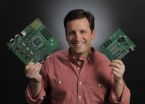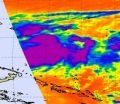(Press-News.org) It's a digital world. Or is it?
NASA technologist Jonathan Pellish isn't convinced. In fact, he believes a computing technology of yesteryear could potentially revolutionize everything from autonomous rendezvous and docking to remotely correcting wavefront errors on large, deployable space telescope mirrors like those to fly on the James Webb Space Telescope.
"It's fast forward to the past," Pellish said, referring to an emerging processing technology developed by a Cambridge, Mass.-based company, Analog Devices Lyric Labs.
So convinced is he of its potential, Pellish is meeting with scientists and engineers to explain the technology's capabilities and is using fiscal year 2013 NASA Center Innovation Fund resources to build printed circuit boards that researchers can use to test the technology's performance for a range of scientific applications. Pellish works at NASA's Goddard Space Flight Center in Greenbelt, Md. He also has carried out preliminary radiation-effects studies to see how the technology's architecture holds up under the extreme environment encountered in space.
"I wouldn't do it unless I really believed in it," Pellish added. "This is one of the few things I've seen that is really different than what others are trying to do. I think this technology could fundamentally change the way we carry out onboard processing."
Analog-Based Microchip
The new technology is an analog-based microchip developed with significant support from the Defense Advanced Research Projects Agency (DARPA). Instead of relying on tiny switches or transistors that turn on and off, producing streams of ones and zeroes that computing systems then translate into something meaningful to users, the company's new microchip is more like a dimmer switch. It can accept inputs and calculate outputs that are between zero and one, directly representing probabilities, or levels of certainty.
"The technology is fundamentally different from standard digital-signal processing, recognizing values between zero and one to accomplish what would otherwise be cost prohibitive or impossible with traditional digital circuits," Pellish said.
The processor's enhanced performance is due to the way the technology works, he explained. While digital systems use processors that step through calculations one at a time, in a serial fashion, the new processor uses electronic signals to represent probabilities rather than binary ones and zeros. It then effectively runs the calculations in parallel. Where it might take 500 transistors for a digital computer to calculate a probability, the new technology would take just a few. In other words, the microchip can perform a calculation more efficiently, with fewer circuits and less power than a digital processor — attributes important for space- and power-constrained spacecraft instruments, Pellish said.
Although "there has been an overwhelming amount of positive support for the technology within Goddard" since Pellish began introducing colleagues to its capabilities, he is the first to concede that the technology isn't appropriate for all space applications.
Fast Fourier Transform
Because of its efficiency and inherent design, however, it's especially ideal for computing fast Fourier transforms (FFTs), and more particularly the discrete Fourier transform, a ubiquitously used mathematical algorithm in digital-signal processing. Among other things, Fourier transforms decompose signals into their constituent frequencies and are used to generate and filter cell-phone and Wi-Fi transmissions as well as compress audio, image and video files so that they take up less bandwidth.
Among other products, the company has developed an analog-based integrated circuit geared specifically for computing Fourier transforms. The team will use the technology, which the company donated, to assemble several custom circuit boards. "We'll take the hardware and see what it can do with our data and applications," Pellish explained.
One of the first applications the group plans to target with a version of the FFT integrated circuit is wavefront sensing and control, the computational technique for aligning multiple mirror segments, like those that are flying on the Webb telescope, so that they operate as a single mirror system.
In addition, Jeffrey Klenzing, who works with Goddard's Space Weather Laboratory, wants to evaluate the technology's use for on-board data processing, particularly for studies of the sun. "For a typical sounding rocket application, we send all data down and perform fast Fourier transforms on the ground. However, for satellite missions, this is not feasible given limited telemetry," Klenzing said. "A chip for performing rapid, reliable FFTs would be very useful for such heliophysics missions particularly with the push toward smaller, low-power satellites such as CubeSats and nanosats."
Pellish also believes autonomous rendezvous and docking and other applications requiring precise locational information would benefit from the analog-based technology. "We're trying to create a new market at NASA for analog processing. I believe it will give us a competitive edge. If we can push this, it could revolutionize how we do onboard data processing."
INFORMATION:
Fast forward to the past: NASA technologists test 'game-changing' data-processing technology
2012-11-28
ELSE PRESS RELEASES FROM THIS DATE:
NASA sees Tropical Storm Bopha intensifying in Micronesia
2012-11-28
Tropical storm warnings are in effect in Micronesia as NASA and other satellite imagery indicates that Tropical Storm Bopha continues to intensify.
The Atmospheric Infrared Sounder (AIRS) instrument that flies aboard NASA's Aqua satellite captured an infrared image of Tropical Storm Bopha on Nov. 27 at 0241 UTC that indicated a lot of power exists in the strengthening tropical storm. The AIRS image captured the eastern half of the tropical storm and showed a large area of very cold, very high cloud tops, where temperatures colder than -63 Fahrenheit (-52 Celsius) have ...
High altitude climbers at risk for brain bleeds
2012-11-28
CHICAGO – New magnetic resonance imaging (MRI) research shows that mountain climbers who experience a certain type of high altitude sickness have traces of bleeding in the brain years after the initial incident, according to a study presented today at the annual meeting of the Radiological Society of North America (RSNA).
High altitude cerebral edema (HACE) is a severe and often fatal condition that can affect mountain climbers, hikers, skiers and travelers at high altitudes—typically above 7,000 feet, or 2,300 meters.
HACE results from swelling of brain tissue due ...
Most patients in the dark about what radiologists do
2012-11-28
CHICAGO – The role of radiologists in healthcare has long been poorly understood among the general public, but new research presented today at the annual meeting of the Radiological Society of North America (RSNA) shows that even patients who've had imaging exams in the past know little about the profession.
Researchers said the study findings highlight an opportunity for radiologists to educate the public about their role in healthcare.
"We know from previous studies that about half of the general public doesn't even know that radiologists are physicians," said Peter ...
Men with belly fat at risk for osteoporosis
2012-11-28
CHICAGO – Visceral, or deep belly, obesity is a risk factor for bone loss and decreased bone strength in men, according to a study presented today at the annual meeting of the Radiological Society of North America (RSNA).
"It is important for men to be aware that excess belly fat is not only a risk factor for heart disease and diabetes, it is also a risk factor for bone loss," said Miriam Bredella, M.D., radiologist at Massachusetts General Hospital and associate professor of radiology at Harvard Medical School in Boston.
According to the National Center for Health ...
CT depicts racial differences in coronary artery disease
2012-11-28
CHICAGO – While obesity is considered a cardiovascular risk factor, a study presented today at the annual meeting of the Radiological Society of North America (RSNA) showed that African-American patients with coronary artery disease (CAD) have much less fat around their hearts compared to Caucasian patients.
"Prior evidence suggests that increased fat around the heart may be either an independent marker of CAD burden or a predictor of the future risk of acute coronary events," said U. Joseph Schoepf, M.D., professor of radiology and medicine and director of cardiovascular ...
New study: Many flame retardants in house dust -- unsafe levels
2012-11-28
A peer-reviewed study of the largest number of flame retardants ever tested in homes found that most houses had levels of at least one flame retardant that exceeded a federal health guideline. The journal Environmental Science & Technology will publish the study online on November 28, 12:01am Eastern.
The study led by scientists at Silent Spring Institute tested for 49 flame retardant chemicals in household dust, the main route of exposure for people and especially for children. Forty-four flame retardant chemicals were detected and 36 were found in at least 50% of the ...
Complications challenge rheumatoid arthritis patients after joint replacement surgery
2012-11-28
In the first systemic review of evidence assessing complications following total joint arthroplasty, patients with rheumatoid arthritis (RA) were found to have an increased risk for hip dislocation after hip replacement surgery compared to those with osteoarthritis (OA). Study findings published online in Arthritis & Rheumatism, a journal of the American College of Rheumatology (ACR), also indicate that RA patients have a higher infection risk following total knee replacement than patients with OA.
The ACR reports that OA—the most common form of arthritis—affects 27 ...
Printing soil science
2012-11-28
Imagine printing a 3-D object as easily as a typed document. Lose a button? Print one. Need a new coffee cup? Print one. While the reality of printing any object on demand may lie in the future, the technology necessary to do it has been available for decades. And soil scientists are now taking advantage of its possibilities.
In a paper published online this week in the Soil Science Society of America Journal, a team of researchers headed by Philippe Baveye explored the potential of manufacturing soil science equipment using 3-D printing. They found that the technology, ...
NREL researchers use imaging technologies to solve puzzle of plant architecture
2012-11-28
Scientists at the U.S. Department of Energy's National Renewable Energy Laboratory (NREL) and the BioEnergy Science Center (BESC) combined different microscopic imaging methods to gain a greater understanding of the relationships between biomass cell wall structure and enzyme digestibility, a breakthrough that could lead to optimizing sugar yields and lowering the costs of making biofuels.
A paper on the breakthrough, "How Does Plant Cell Wall Nanoscale Architecture Correlate with Enzymatic Digestibility?" appears in the current issue of Science Magazine.
Principal ...
The Threat of Sleepy Drivers in Illinois
2012-11-28
The Threat of Sleepy Drivers in Illinois
Many of us continue to do it even though we know we should not: driving when drowsy. As distracted driving becomes a major road safety concern in Illinois, so too does drowsy driving. Driving tired slows reaction time, decreases awareness and impairs judgment just like drinking and driving and distracted driving. To prevent accidents and to safeguard others on the road, drivers in Illinois should safely pull over when they become too tired to drive.
According to the National Highway Traffic Safety Administration, sleepy drivers ...

